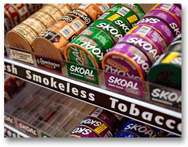Youth’s exposure to smokeless tobacco unaffected despite non-marketing agreement

Washington, Oct 5 : The Master Settlement Agreement (MSA) of 1998, which was designed to limit the marketing of smokeless tobacco to youth, has failed to generate the desired results, according to a new study by researchers at the University of Georgia.
“Exposure rates are significant and have been very stable over the past 10 years,” said study co-author Dean Krugman, professor in the UGA Grady College of Journalism and Mass Communication.
“We need to be vigilant about what this industry is doing because of the health consequences and the fact that major cigarette marketers - R.J. Reynolds and Philip Morris, which have heretofore not had smokeless products - are both introducing and test marketing smokeless products,” he added.
The agreement, signed by major cigarette producers with the Attorney Generals from 46 States, called for the elimination of billboard advertising, cartoons in tobacco advertising and marketing toward youth.
The same year, a similar agreement known as the Smokeless Tobacco Master Settlement Agreement (STMSA) was signed by the attorney generals and US Smokeless Tobacco Company, the largest smokeless tobacco manufacturer.
Krugman and co-authors Margie Morrison and Pumsoon Park have found that while smokeless tobacco advertising in magazines reached 66 percent of adolescents in 1993, the ads reached 64 percent of adolescents in 2002, the last year for which figures are available.
The researchers analysed data on readership and advertising in popular magazines over a 10-year period, and identified magazines used by smokeless tobacco advertisers, which included Rolling Stone, Spin, Sports Illustrated and Sporting News.
According to them, smokeless tobacco advertising in magazines actually increased in the first year after the STMSA went into effect, reaching 83 percent of adolescents. The exposure to such advertisements reduced sharply to 57 percent in 2000, but rates steadily increased in later years, the researchers say.
“Despite the fact that we have the Smokeless Tobacco Master Settlement Agreement in place, these messages are still getting to a substantial number of youth,” said lead author Morrison, associate professor in the School of Advertising and Public Relations at the University of Tennessee-Knoxville.
“Our study is one of the first to actually look at this topic and provides a baseline for assessing youth exposure levels and monitoring the smokeless tobacco industry,” the author added.
Krugman said that the research studies have shown that smokeless tobacco is not a safe alternative to cigarettes and could cause cancers of the mouth and throat and other negative health consequences.
He also said that the smokeless tobacco manufacturers avoid scrutiny, most likely because the research and policy emphasis had been on the consequences of cigarette smoking, which involved higher levels of marketing and enormous health consequences.
“From a public policy perspective, this is flying under the radar. Researchers and policymakers who are concerned about youth tobacco use should not stop at cigarettes,” Krugman said.
The study is published in the online edition of the American Journal of Public Health. (With inputs from ANI)